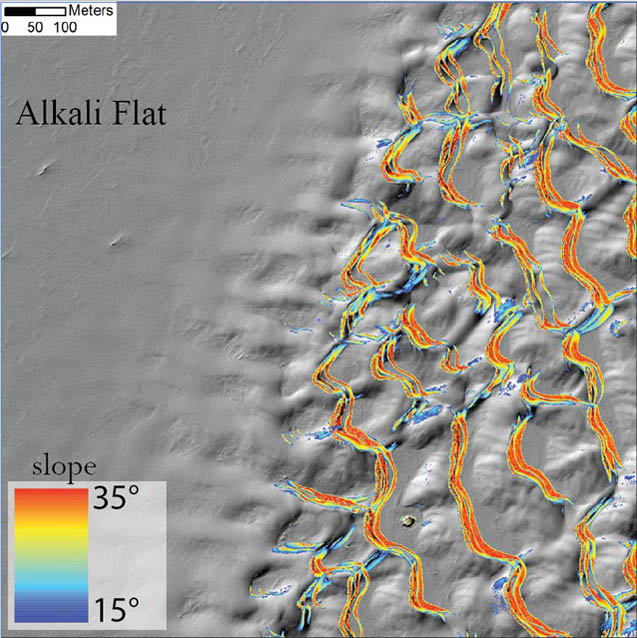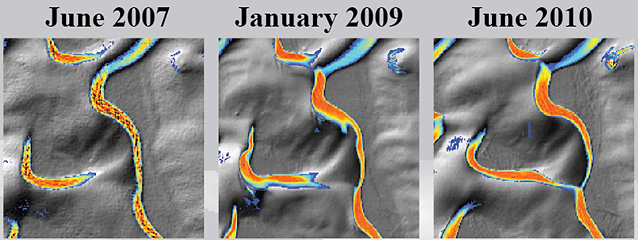Sand dunes cover vast areas of the Earth’s desert regions and are widespread across Venus, Mars, and Saturn’s moon, Titan. Sand dunes are very sensitive indicators of changing climate and environmental conditions, and landscapes created by sand dunes can provide a detailed record of past surface conditions on the planetary surfaces.
Reading the climate record from these landscapes and understanding how these landscapes change with changing environmental conditions is a great challenge because sand dunes are formed through complicated interactions between the sand, wind, and the surface topography they create as they grow. Ultimately, the complicated interplay among these three variables records the climate conditions during the formation of dunes and dune-covered landscape patterns.

R. C. Ewing
How do sand dunes grow? How do sand dune patterns form? White Sands National Monument (NM) provides an ideal natural laboratory to study the dynamics of sand dunes and the creation of a landscape pattern to answer these questions because the dunes at White Sands NM are growing and changing the entire year.
|
Objectives The goal of this research is to quantitatively map changes in the sand dunes at White Sands National Monument from the upwind margin of the dune field, where the first dunes appear, into the interior of the dune field. Objective 1 - Create a database of high-resolution satellite, aerial imagery and airborne Light Detection and Ranging (LiDAR) data that covers five to ten years of change within the dune field. Objective 2 - Map individual dune crestlines from the upwind margin into the interior of the dune field. Objective 3 - Identify specific areas and types of change within the dunes. Objective 4 - Measure and analyze the amount of change in identified areas. |
Methods
Time-series aerial photographs from 1944, 1963, 1977, 1985, 1996, 2003, 2005, and 2010 and airborne LiDAR (Light Detection and Ranging) collected June 2007, June 2008, January 2009, September 2009, and June 2010 over the core of White Sands Dune Field provide the basis to examine different areas of change within the dune field. Aerial photographs are used within a Geographic Information System (GIS) database and individual dune crestlines are mapped through manual digitization. LiDAR provides three-dimensional data about the dunes, which allows the volume of sand that is moved over time in the dunes to be quantified. Corresponding weather data from Holloman Air Force Base and the White Sands Missile Range are analyzed during the time period covered by the imagery.
Results and Discussion
At the upwind margin of White Sands Dune Field, sand dunes emerge abruptly over a few hundred meters from the mostly sand-bare Alkali Flat that sits to the west of the dune field (Figure 1). The first dunes that emerge are a few meters high and migrate up to six meters per year, but within the first few kilometers downwind of the upwind margin the dunes have grown to 6-10 meters high and are moving around three meters per year.
Our research indicates that the primary mechanism by which sand dunes at White Sands NM grow and organize is through interactions between the dunes themselves (Figure 2). Fast moving sand dunes collide with slower moving dunes and their masses merge to produce a dune that is larger. Over time and distance, dune mergers result in an organized pattern of dunes that are about the same size, migrate at about the same rate, and interact less frequently. Based upon analysis of aerial photos and LiDAR data, most interactions that promote dune growth occur within one kilometer of the upwind margin. Further downwind of the margin, interactions that promote slower dune growth and pattern maintenance occur so there is less pattern change.

R. C. Ewing
Being able to measure how sand dunes change through space and time has revealed a new aspect of sand dune patterns. We now recognize that sand dunes are nearly always interacting, and it is these interactions that generate the larger-scale patterns. How are dune interactions impacted by changes in the winds, vegetation, or water table? Understanding how dune interactions occur will allow us to predict how the dunes at White Sands NM will change in the future and provide new ways to read patterns on other planets.
Management Implications
Natural and man-made changes to climate and the environment can have a profound impact on the sand dunes at White Sands NM. Sand dunes change quickly when new sediment is added or removed. This can happen when the water table drops because of climate change, increased urbanization, or agriculture. White Sands attracts many visitors, and understanding how the dunes change allows us to assess how the visitors may impact the natural progression of the dunes and if there is any future impact.
For more information, contact:
Ryan C. Ewing, ryanewing@gmail.com
Department of Geology and Geophysics
Texas A&M University
In collaboration with Gary Kocurek, University of Texas- Austin; Douglas J. Jerolmack, University of Pennsylvania; and David Bustos, National Park Service-White Sands NM.
Prepared in collaboration with the National Park Service, 2012.
Last updated: December 29, 2016
